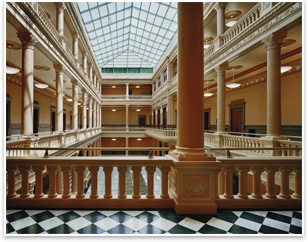
| User’s Guide: The General Services Administration’s Design Excellence Program The nation’s largest public real estate owner is still building
Summary: The U.S. General Services Administration (GSA) Design Excellence program was created to encourage the design of memorable, high-quality, and efficient federal government buildings. It brings public and private sector experts together to select architects and building designs in a carefully planned, two-step process. Visit the GSA’s Web site. See what business opportunities are on FedBizOps. Listen to a podcast about GSA mandates on Building Information Modeling.Listen to a podcast about GSA mandates on Building Information Modeling. Visit the AIA’s guide to federal procurement (member sign in required). Balancing Design Excellence and Building Security at New U.S. Embassies 1. The Oklahoma City Federal Building by Ross Barney Architects. Photo © Steve Hall, Hedrich Blessing. 2. The Sault Ste. Marie Border Station by Ross Barney Architects. Photo © Jon Miller, Hedrich Blessing. 3 and 4. Kliment and Halsband’s U.S. Post Office and Courthouse in Brooklyn. Photos © Cervin Robinson. See what the Public Architects Knowledge Community is up to. The AIA’s resource knowledge base can connect you to “21st Century Public Architecture: Design Excellence,” a panel discussion about how the Design Excellence portfolio of buildings has impacted our culture of public works. See what else SOLOSO has to offer for your practice.
With 200 active projects across the nation, the GSA Design Excellence program offers architects a diverse array of public and civic projects in the midst of an otherwise darkening building design and construction market. The GSA is the nation’s largest public real-estate organization, with hundreds of millions of square feet that house millions of federal workers under its purview. It is responsible for all federal building projects, with the exception of U.S. embassies, memorials and monuments, post offices, and Department of Defense facilities. The Design Excellence program is meant to emphasize the role of the lead architecture designer in creating efficient, sustainable, and quality-designed buildings that are worthy of the public trust and civic role of the federal government. The current incarnation of the Design Excellence program began in 1994, after the previous two GSA design awards juries (from 1990 and 1992) gave out no awards. To find a way to facilitate architecture that reached beyond these repeated crops of uninspired designs, the GSA gathered the 1990 and 1992 jury members together for a conference. They settled on two key ideas that would guide the new Design Excellence program: elevating and highlighting the position of the lead architect of the project and having private-sector design peers lend their expertise and credibility to the process, thereby breathing renewed life into federally funded buildings. “It was a perfect storm solution to the mediocre design work that had been done in the past,” says Leslie Shepherd, AIA, chief architect of the GSA. Process and criteria In stage I, firms select projects they’re interested in from the FedBizOps Web site and submit their portfolios, which are evaluated by a panel of five voting members:
This group evaluates the architects’ portfolios, based on their philosophy and design intent, professional profile, and (most importantly) past design performance.
“We’re able to really see how the team is going to work together, not just the lead designers,” Shepherd says of the charrettes. “It’s more like an extended interview.” The GSA occasionally adds an additional 30-day conceptual design phase to the process, but Shepherd says the agency is moving away from this extra step because it weds architects to a single design concept very early in the process and is too expensive for designers who might not be rewarded with the commission. The Back Story: When a lead designer is selected, they are asked to prepare three different designs for each project. These designs are all reviewed by a GSA representative and three private-sector peers, including at least one charrette juror when possible. From these three designs, the best qualities of each are integrated into one plan, and a final design is chosen
Frances Halsband, FAIA, of the New York City-based firm Kliment and Halsband, says that the strictly delineated process and simple paperwork attracted her 25-person firm to GSA projects. “Without that process we never, never, never would have gone anywhere near anything that had a federal government label on it,” she says. Her firm’s design for a courthouse and post office in Brooklyn received a Design Excellence award in 1998. Securing this project turned out to be easier than Halsband had imagined. “We felt we had no political connections, no best friends who were congressmen. It was something that never even crossed our minds. We really just showed up on a lark.” Shepherd says that GSA projects are not only large, complex commissions with budgets measured in the hundreds of millions. Some projects are as small as $10 million. There is no such thing as a typical timeline for GSA projects, Shepherd says, though there are often two years between the start of the process and the beginning of construction. Additionally, LEED® Standard certification is required for all Design Excellence projects, but LEED Silver is the agency’s goal.
“Go after the kind of work you’re best at,” says Shepherd. “Our experience working on it was that in fact the federal government is just like any other client interested in good design, which is a rare and wonderful thing,” says Halsband. |
||
Copyright 2008 The American Institute of Architects. All rights reserved. Home Page |
||
news headlines
practice
business
design
recent related
› Doer’s Profile: Leslie Shepherd, AIA
› GSA Building Modernization: Design Excellence and LEED Gold Certification
› Members Connect with Federal Agencies at Expo 2007
› Balancing Design Excellence and Building Security at New U.S. Embassies

 How do you . . .
How do you . . .  Building Type Basics for Justice Facilities
Building Type Basics for Justice Facilities From there, the panel selects three to six short-listed firms to be evaluated in stage II. Each firm is interviewed by the panel and judged on their team organization and management plan, professional qualifications, and location. Once again, their design performance is weighted the heaviest. At this point, a final architect may be selected, or the GSA may elect to add a one-day charrette to stage II, an opportunity for the entire building design and construction team to work through initial project conceptualizations. A separate charrette jury (often consisting of a design educator, architecture critic, and practicing architect with experience in the applicable building type) reports back to the selection panel on:
From there, the panel selects three to six short-listed firms to be evaluated in stage II. Each firm is interviewed by the panel and judged on their team organization and management plan, professional qualifications, and location. Once again, their design performance is weighted the heaviest. At this point, a final architect may be selected, or the GSA may elect to add a one-day charrette to stage II, an opportunity for the entire building design and construction team to work through initial project conceptualizations. A separate charrette jury (often consisting of a design educator, architecture critic, and practicing architect with experience in the applicable building type) reports back to the selection panel on: Do what you do best
Do what you do best Because the evaluation weightings are so heavily based on past design performance, Carol Ross Barney, FAIA, whose Chicago-based firm has won multiple Design Excellence awards, says those interested in finding GSA work should focus on projects that demonstrate the firm’s deepest design strengths.
Because the evaluation weightings are so heavily based on past design performance, Carol Ross Barney, FAIA, whose Chicago-based firm has won multiple Design Excellence awards, says those interested in finding GSA work should focus on projects that demonstrate the firm’s deepest design strengths.